



Table of Contents
- Introduction to Feng Shui Bagua Mirrors
- What is a Feng Shui Bagua Mirror?
- Types of Feng Shui Bagua Mirrors - Convex Bagua Mirrors
- Concave Bagua Mirrors
- Plane Bagua Mirrors
- Feng Shui Bagua Mirrors Colours and Significance
- How to Use Feng Shui Bagua Mirrors
- What is a Bagua Map?
- How to Apply the Bagua Map For Your Home
- Tips and Taboos for Using Bagua Mirrors
- Conclusion
- Faq's
Introduction to Feng Shui Bagua Mirrors
Feng shui is an ancient Chinese practice that aims to harmonise individuals with their surrounding environment.
A key tool in feng shui is the Bagua mirror, which is believed to have protective and auspicious properties. The Bagua mirror, also known as the Pa Kua mirror, is a well-known classic feng shui adjustment object.
In this article, we will explore the meaning, types, uses, and important tips and taboos regarding Feng Shui Bagua mirrors. We will also discuss how to properly apply the Bagua map to your home or space to maximize the benefits of these powerful mirrors.
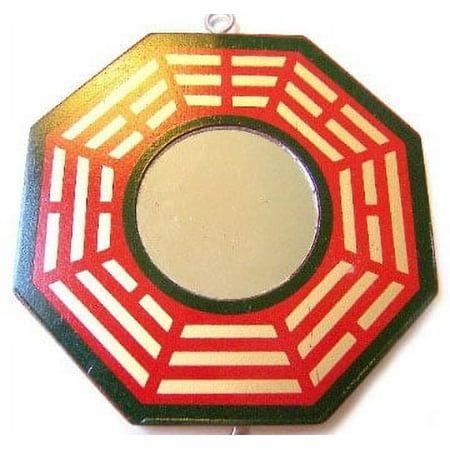 Red Feng Shui Bagua Mirror, Pinterest
Red Feng Shui Bagua Mirror, Pinterest
What is a Feng Shui Bagua Mirror?
A Bagua mirror is an octagonal mirror that features the eight trigrams of the Bagua, along with the Yin-Yang symbol in the center. The eight trigrams, known as the Pa Kua, represent the fundamental principles of reality according to Taoist philosophy.
Bagua mirrors are traditionally placed outside at the main entrance or front door of a home.
They are used as protective amulets to deflect negative energy or "poison arrows" that may be directed towards the home. Bagua mirrors are especially recommended if there is a sharp roof line, corner of a building, or other inauspicious feature pointing towards the front door.
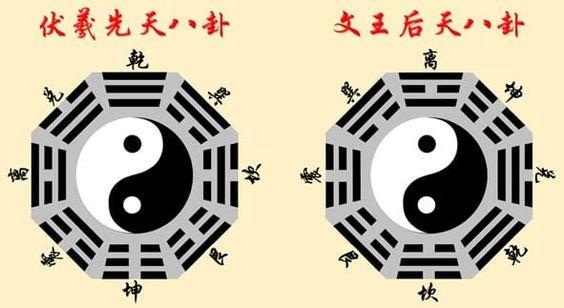 Source: Pinterest
Source: Pinterest
Types of Feng Shui Bagua Mirrors - Convex Bagua Mirrors
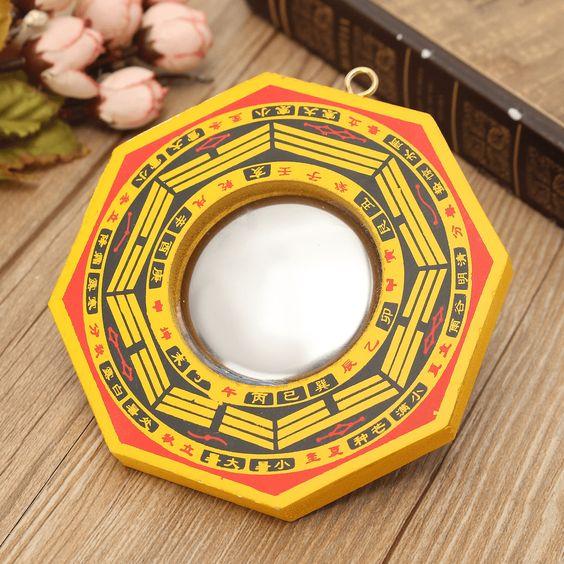 Convex Bagua Mirror, Pinterest
Convex Bagua Mirror, Pinterest
Convex Bagua mirrors are specifically shaped like an octagon, with each side and the center representing one of the nine areas of the Bagua. This unique shape allows them to double the chi or life force energy and infuse it into the atmosphere.
The primary use of convex Bagua mirrors is to deflect fast-moving negative energy or "poison arrows" coming from inauspicious features outside the home. These can include sharp corners of buildings, T-intersections, cul-de-sacs, or other structures that are believed to direct negative chi towards the property.
By deflecting this negative energy, convex mirrors are thought to help prevent accidents, protect against theft, and calm overwhelming feelings in the home. They create a protective barrier around the space and regularize irregular shapes that are considered inauspicious in feng shui.
However, it's crucial to note that convex mirrors should only be used when there is a specific need to deflect negative energy. They should never be placed indiscriminately or used as mere decoration, as improper placement can amplify the negative chi. Consulting with a feng shui expert is recommended to determine if a convex mirror is necessary and where to position it for maximum effectiveness.
Concave Bagua Mirrors
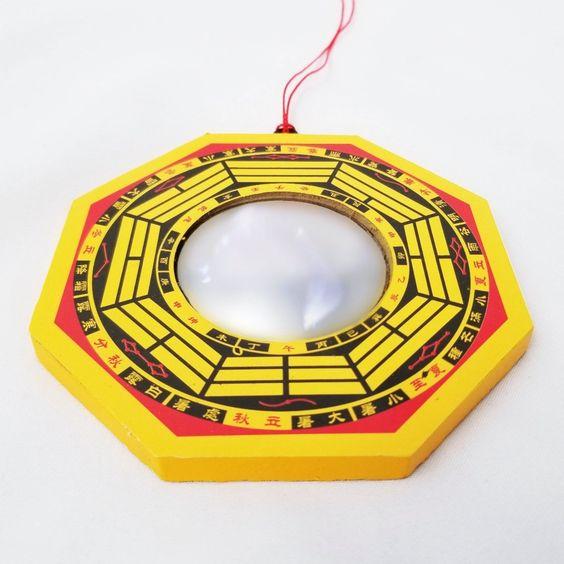 Concave Bagua Mirror, Pinterest
Concave Bagua Mirror, Pinterest
Concave Bagua mirrors are believed to have the unique ability to attract and collect positive chi energy. Unlike convex mirrors that reflect and deflect, concave mirrors draw in the life force energy of the surrounding environment.
One of the primary uses of concave mirrors is to nullify "poison arrows" or negative energy directed at the home. Instead of reflecting the energy back, the concave surface absorbs it into itself, neutralising the harmful effects.
These mirrors are also recommended for certain inauspicious feng shui situations, such as when the front gate faces a downward stairway or open slope, which can lead to unstable family fortune or declining luck in making money. Concave mirrors are placed on the gate to collect the energy released.
Additionally, concave Bagua mirrors are used to capture positive chi from pleasant outdoor scenery like rivers, mountains, or gardens. By reflecting these auspicious elements, they are believed to bring good luck and prosperity to the home.
However, it's crucial to consult with a feng shui expert before using a concave mirror, as improper placement can have unintended consequences. Concave mirrors should never be used indoors, as they are thought to absorb the yin energy within the space.
Plane Bagua Mirrors
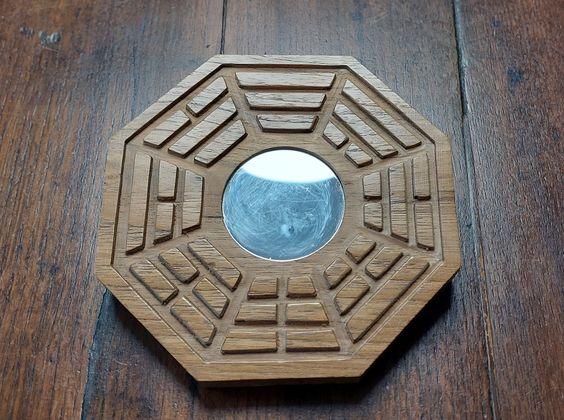 Plane Bagua Mirror, Pinterest
Plane Bagua Mirror, Pinterest
Plane Bagua mirrors are the most common type used in feng shui. They consist of an octagonal frame featuring the Bagua colors and trigrams, with a flat mirror surface in the center.
Unlike convex mirrors that double the chi energy, plane mirrors can either collect or reflect energy depending on the specific situation. They are often used to block out negative energy from inauspicious features like sharp corners, T-intersections, or Yin items such as cemeteries, hospitals, or ancient houses in disrepair.
Plane mirrors are also recommended for homes facing a vertical road, close to a highway or waterway, or next to fire elements like high-voltage lines or radio towers. By reflecting the negative chi, they create a protective barrier around the property.
However, plane mirrors should never be used indoors, as they can collect and concentrate negative energy within the space. They are always hung outside the building, facing outwards towards the source of the negative chi.
It's important to note that plane mirrors should be made of high-quality materials, with bronze being the most effective in feng shui. Improper materials or construction can diminish the mirror's ability to deflect negative energy effectively.
Feng Shui Bagua Mirrors Colours and Significance
Feng Shui Bagua mirrors come in various colors, each carrying specific meanings and energies that can enhance their effectiveness. Here are the primary colors of Bagua mirrors and their associated meanings:
Red Bagua Mirrors
Red mirrors are often associated with summer and symbolize illumination, growth, and vitality. In feng shui, red is a powerful color that represents protection and good fortune. The vibrant energy of red is believed to enhance the mirror's ability to repel negative energy and "poison arrows" directed at the home. Using a red Bagua mirror can create a dynamic and protective atmosphere, making it an excellent choice for areas that require heightened energy and defense against negativity.
Green Bagua Mirrors
Green mirrors represent spring and are linked to inspiration, renewal, and strength. This color is associated with growth and harmony, making it suitable for spaces where creativity and positive energy are desired. Green is also connected to the wood element in feng shui, which promotes vitality and flourishing energy. Utilizing a green Bagua mirror can enhance the energy of a space, fostering a sense of balance and encouraging new beginnings.
Gold Bagua Mirrors
Gold mirrors are associated with late summer and fall, symbolising productivity, success, and abundance. The color gold is often linked to wealth and prosperity, making it an ideal choice for areas focused on financial growth and stability. Using a gold Bagua mirror can attract positive energy related to success and achievement, enhancing the overall atmosphere of abundance in your home or workspace.
In addition to these primary colors, Bagua mirrors may also feature various designs and motifs that resonate with different energies. When selecting a Bagua mirror, consider the specific energy you wish to cultivate in your environment and choose a color that aligns with your intentions.
How to Use Feng Shui Bagua Mirrors
The most common use of Bagua mirrors is to hang them above the main entrance or front door, facing outwards. This is done to deflect any negative energy or "poison arrows" directed at the home. Mirrors should be hung at noon (11am-1pm), when Yang energy is at its peak.
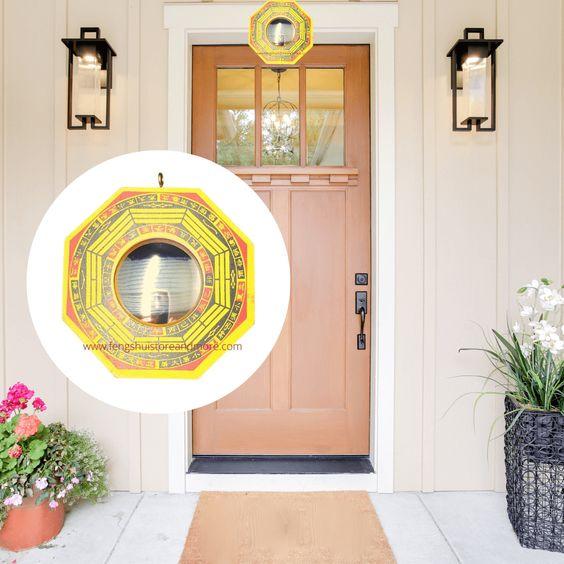
Bagua mirrors can also be used in other ways:
- If the main door faces in an inauspicious direction like East or Southeast, a mirror can be hung at the center point of the door to restrict bad energy from entering. Mirrors can be placed if the main door faces a sharp corner, police station, graveyard, hospital, butcher shop or nursing home.
- In small spaces, mirrors can be used to create an illusion of depth and double the size of the area.
- Mirrors in hallways and dark spaces help circulate stagnant chi energy.
- Irregular spaces can be "regularised" by placing mirrors to recreate missing parts and make the shape more balanced.
- It's important to note that Bagua mirrors should always be hung facing outwards and never indoors. The maximum recommended number of mirrors is three, with one in each direction.
What is a Bagua Map?
A Bagua map is a fundamental tool in Feng Shui that serves as a guide for analyzing the energy flow within a space. It is typically represented as an octagonal grid divided into nine sections, each corresponding to different aspects of life, such as wealth, health, relationships, and career. The sections of the Bagua map are aligned with specific areas of a home or room, allowing practitioners to identify where to enhance or remedy energy imbalances.
To effectively use the Bagua map, one must overlay it onto the floor plan of a space, ensuring that the wall with the main entrance is at the bottom of the map. Each section of the Bagua corresponds to a specific area of life and is associated with corresponding colors, elements, and shapes. For example, the Wealth area is linked to abundance and prosperity, while the Love area focuses on relationships and partnerships.
By understanding and applying the Bagua map, individuals can strategically place Feng Shui elements, such as mirrors, plants, or colors, to enhance positive energy and mitigate negative influences in their environment. This practice aims to create harmony and balance, ultimately improving overall well-being and quality of life.
How to Apply the Bagua Map For Your Home
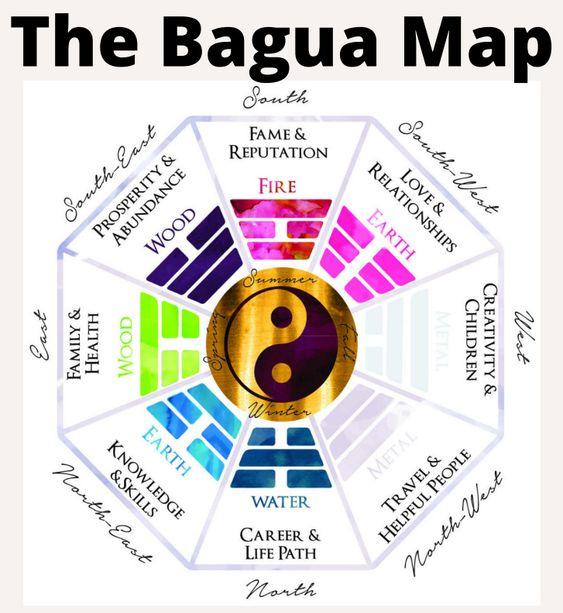 The Bagua Map, Source: Pinterest
The Bagua Map, Source: Pinterest
To properly apply the Feng Shui Bagua map to your home or space, follow these steps:
- Obtain an accurately scaled floor plan of your home or room.
- Rotate the plan so the wall with the front door is at the bottom.
- Overlay a three-by-three grid, aligning the bottom of the grid with the wall containing the front door. The grid should be equally spaced.
- Locate the different Bagua areas on the grid, matching them up with the corresponding areas of your home.
The nine Bagua areas and their associated attributes are:
- Family & New Beginnings (East) - Green, blue, teal colors; Yang wood element
- Wealth & Abundance (Southeast) - Blue, green, purple colors; Yin wood element
- Health & Center - Earth tones, yellow, orange, brown colors; Earth element
- Helpful People & Travel (Northeast) - Gray colors; Yang metal element
- Children & Creativity (North) - White color; Yin metal element
- Knowledge & Self-Cultivation (Northwest) - Dark blue, black, green colors; Yang earth element
- Fame & Reputation (South) - Red color; Fire element
- Career & Life Path (Northeast) - Black color; Water element
- Love & Marriage (Southwest) - Pink color; Earth element
It's recommended to activate only 1-3 Bagua areas at a time by bringing in the associated colors, elements or shapes. Activating too many areas can dilute the effects.
Tips and Taboos for Using Bagua Mirrors
Here are some important tips and taboos to keep in mind when using Feng Shui Bagua mirrors:
- Always hang mirrors at noon (11am-1pm) when Yang energy is strongest.
- Avoid reflecting light from mirrors into other people's homes, as this can bring negative energy to them.
- Never hang mirrors so they reflect pictures of gods, Buddhas or statues, as this is disrespectful.
- Mirrors should always be hung outdoors, never indoors.
- Limit the number of mirrors to a maximum of three, with one in each direction.
- Never look directly into a Bagua mirror when passing by.
- Avoid hanging mirrors on ceilings, as this can wear away your luck.
- Mirrors reflecting the main front door cause wealth to instantly flow out again.
- Mirrors opposite each other or a door/window cause restlessness and should be avoided.
- Mirrors reflecting the bed in a bedroom can lead to sleep problems and extramarital affairs.
- Mirrors reflecting the stove can lead to accidents.
Conclusion
The Feng Shui Bagua mirror is a powerful tool for deflecting negative energy, attracting positive chi, and creating balance in your living environment.
By properly applying the Bagua map, choosing the right type of mirror, and following key tips, you can harness the protective and auspicious properties of these mirrors.
Remember, the key to effective feng shui is creating harmony between yourself and your surroundings. Bagua mirrors are just one element in this ancient practice. By incorporating them thoughtfully and in moderation, you can enhance the positive energy flow in your home and life.
explore further
Latest from Contemporary ideas
More from Innovations
Resources
Dwello, for every home buyer, is a way to go from 'I feel' to 'I know', at no extra cost.




